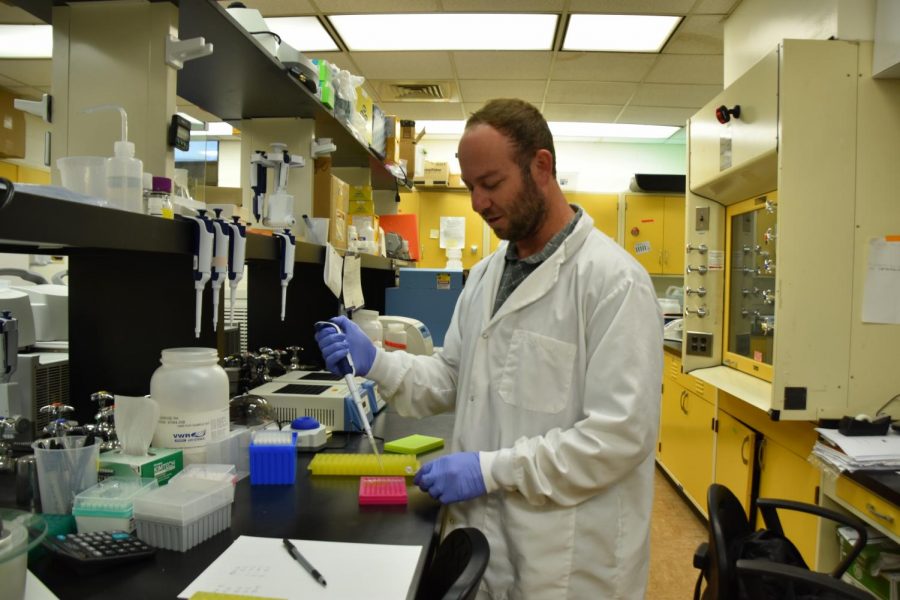Breeding between wild and domestic animals, known as hybridization, can bring upon complicated consequences and it can happen when people release their pets in the wild. A nearly $1 million-dollar grant provided by the National Science Foundation (NSF) is allowing a UTEP-led research team to further this understanding on the adaptive impacts of hybridization on animal populations.
The team of researchers is led by Dr. Philip Lavretsky, assistant professor in UTEP’s Department of Biological Sciences, and includes principal investigator Dr. Michael Schummer of the State University of New York’s College of Environmental Science and Forestry, senior personnel Dr. Brian Davis of Mississippi State University, as well as collaborators Drs. Helen James and Rob Fleischer of the Smithsonian.
Additional partners include the Forbes Biological Station in Illinois and The California Waterfowl Association. This experienced team will be using the mallard duck as a non-model study system to investigate what happens when domestic and wild animals interbreed in nature.
The research began on Sept. 1 and will continue through the next five years.
It is important to note that mallard ducks are the ancestors of nearly all domestic duck breeds except for the Muscovy duck, Lavretsky explained. As a result of the successful domestication of this animal, the mallards range has now spread all around the world, which has brought them into close contact with their wild populations.
“Not only is the mallard important culturally, ecologically, and agriculturally, I’ve always been interested in studying these birds because of their unique behavior and evolutionary history,” Lavretsky said. “The mallard duck is a study system that I have been working over the last decade, and I believe that they give us a unique chance to understand the impact on the adaptive potential of wild populations when they breed with their domestic version.”
Using state-of-the-art genomics, ancient DNA, and 3D scanning technologies, the research team hopes to employ a three-prong approach to shed light on the outcomes of interbreeding. First, the team will be using full genome sequencing of today’s wild and domestic breeds along with their hybrids to understand what genes may be important in their survival.
Additionally, the team aims to go back in time by looking at changing genetics of North American wild mallards by coupling ancient DNA analyses and the hundreds of mallards sampled over the last century and deposited across museums.
Finally, live wild and domestic mallards will also be brought into captivity to study everything from feeding efficiency, mate choice preference, and growth rates.
“We are really trying to not only understand what happened by going back in time with biological collections, look at the genomes for genetic variation that may be important in the adaptive potential of wild mallards, but also get at mechanisms that may explain some of the recent declining trends in North American mallards,” Lavretsky said. “Specifically, if they cannot eat, they cannot survive through the winter and migrate as well as nest properly, and so with enough generations of less fit individuals you expect a population decline.”
Breeding between wild and domesticated populations can lead to negative results in their populations where they suffer and face decline if certain domestic traits are not adaptive in the wild. Thus, Lavretsky’s team will be shedding light on the importance of domestication and its effects on wild populations.
Importantly, they hope their work will educate the general public about the negatives of releasing their pet ducks, or generally, any domestic animal.
Finally, Lavretsky is excited as this NSF funding provides the opportunity for three to eight of UTEP’s undergraduate students to get paid hands-on research experience.
“It is critical for our students to get such experiences so they can compete in the workforce and continue to be great scientists,” Lavretsky said. “I’ve been building up the mallard system as a perfect study system to investigate domestic and wild population interactions, and with all of this culminating in the funded NSF project makes me extremely excited as we have the resources to really uncover some fundamental and important insight here.”
Isaiah Ramirez may be reached at [email protected]: @_IsaiahRamirez1 on Twitter.












